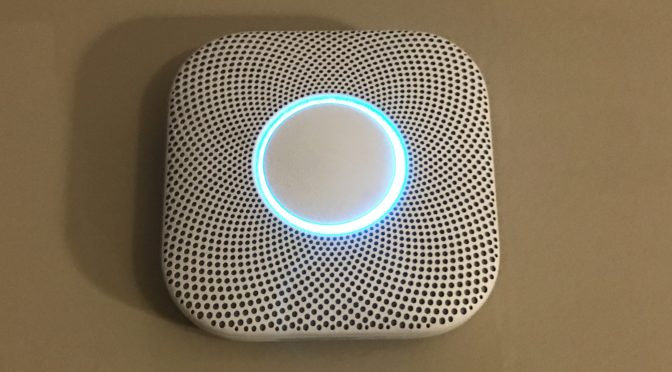Due to what’s probably the collision of boundary-pushing architecture and city fire codes, I had some less than great experiences with smoke detectors in the condo I lived in before I got the house. The smoke detectors in the bedroom and hallway (which was right off a bathroom) went off whenever I so much as thought about cooking bacon or taking a shower, so when I heard about Nest and their Nest Protect smoke detectors, I was intrigued.
I moved in right as Nest released its second-generation Protect smoke/CO detector, and set up three of them: one in my bedroom, one in the hallway outside the bedroom, and one in the basement; just enough to pass muster for fire code (sidenote: this was three more smoke detectors than my house came with. Don’t ask how this house passed inspection with no smoke detectors, I have no idea.)
I was drawn to Nest for a few reasons: first, the design and usability were simple, clean, and intuitive. Second, I liked the idea of being able to control my HVAC system from afar; and third (and most important), my Nest Protects would link together wirelessly and warn me before they start shrieking. The wireless part is a big thing; in older construction, you might be able to get away with installing independent smoke detectors, but code issues aside, you’re still willing to bet that a fire/CO event on a different floor won’t overtake you before you can respond.
Now, 18+ months later, I can say I am on the whole pretty satisfied with the whole Nest situation. A few thoughts:
1. My Nest Protects have yet to so much as utter (did I mention they speak?) a Heads-Up, which may be due to better sensors and algorithms, but might also be due to the fact that my stove and hallway smoke/CO detector are about as far apart as they can be.
2. The daily/monthly metrics provide interesting information, if only informative in nature. Case in point: I can not only see how long, but roughly when (and how often) my HVAC system ran the day(s) prior to today, and on a monthly basis as an aggregate. I swapped my furnace and AC out this last summer for something much more efficient, and while I’ve found that my furnace is running, on average, twice as long as it did before, my gas bill hasn’t really budged.
3. The addition of Home/Away Assist has proven to be an incredibly helpful tool. The first summer I was in the house, I would (naturally) obsess over the web interface for the thermostat, and note that if I lingered in the east half of the house, out of range of the thermostat’s motion sensors, the thermostat would kick into Auto-Away mode. Enabling Auto-Away Assist on the Protects meant my cat could kick the system out of Auto-Away, so that wasn’t an option, but using my iPhone to approximate my location and determine if I was home has proven invaluable; Nest has yet to assume I’m not home since I turned on this feature, no matter where I hide.
4. This may or (probably) may not apply to you, but within 4 days of replacing my furnace and air conditioning, my Nest thermostat’s backplate shorted, disabling my AC. I mention this largely as a word of caution about providing your own Nest thermostat: because I provided my own, the burden on getting a replacement was left to me as well. This meant calling Nest and getting a replacement (which was, truly, a painless process) and then getting my HVAC guys back out to reinstall my Nest thermostat (a less than painless process, plus two trips onsite in total). Evidently this is something that happens with a certain degree of regularity, so if you’re thinking about getting a Nest thermostat, do yourself a favor and see if there’s an HVAC contractor in the area who will sell you one, since they might then be on the hook to help out if you have problems.
5. Aside from the problems I’ve had with the backplate on the thermostat, I love the ease in programming it and controlling it; I can probably count on one hand the number of times I’ve actually adjusted the thing standing in front of it. That said, if you have a house with multiple Nest thermostats, the math might stop adding up pretty quickly. At $250 each, they’re not exactly cheap. That said, they are still functionally similar to your run of the mill bimetallic/digital thermostats, and can work with pretty much* any HVAC system short of a variable-speed or climate-controlled system.
*One thing I noted after having my furnace replaced with a high-efficiency system is that unless the thermostat wiring is replaced, you won’t necessarily get two-stage heating and cooling even if you system is capable of it. I can’t speak to this with any certainty, as I deal with computers, not HVAC, but I have found that my furnace will run at low speed for 5-10 minutes before ramping up to full speed. This may or may not have to do with the doubling on my furnace runtime without any discernable increase in my gas bill.
Bottom line: if you’re not totally thrown by the sticker shock, and you’re willing to accept that your Nest products will probably never integrate with HomeKit at this rate, it’s worth the investment. At the very least, give some solid consideration to the Nest Protects. As John Oliver would put it, I’m not paid to say this, I’m just a fan.

Leave a Reply